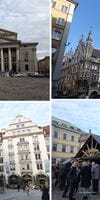The capital of Bavaria - the city of Munich, is rich in various squares.
Many squares in Munich, especially in the historic center, are popular tourist destinations. The squares contain significant sights of the city and (or) historical monuments, there are also fountains, sculptures, cafes, bars and restaurants, shops and accommodation facilities.
Squares in Munich's Old Town
The Old Town of Munich (Altstadt Munich) is the center and most visited part of Munich with an abundance of attractions, historical monuments and interesting places.
In the old town of Munich, the main "tourist life" takes place. Read more about Munich's old town…
Marienplatz
Marienplatz is the heart and main square of Munich.
The center of Marienplatz is decorated with the Mary's Column (Mariensäule), dedicated to Saint Mary as the "patroness of Bavaria". The column was erected in 1638 to celebrate the end of the Swedish occupation during the Thirty Years ' War.
The northern and eastern sides of Marienplatz are marked by two town halls:
- New Town Hall (Neues Rathaus) is a Neo-Gothic brick and stone building that dominates the square, and was built from 1867 to 1909. At the top of the Town Hall tower is an observation deck, giving a 360-degree view of Munich;
- Old Town Hall (Altes Rathaus), which dates back to the 14th century and originated partly from the old Munich city fortifications, which were converted into a 56-meter-high town hall tower. The Toy Museum (Spielzeugmuseum) is located on the four floors of the Town Hall tower. Read more about Marienplatz…
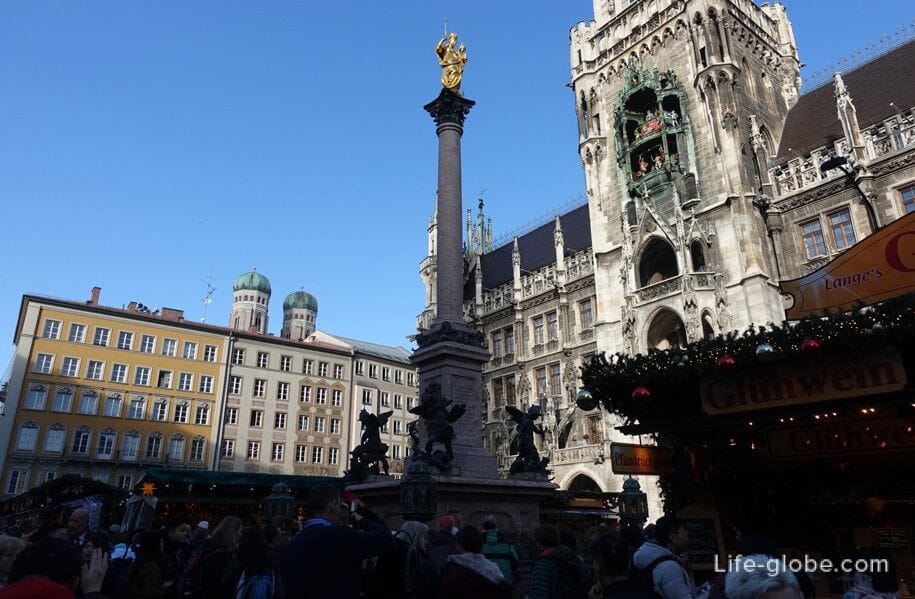
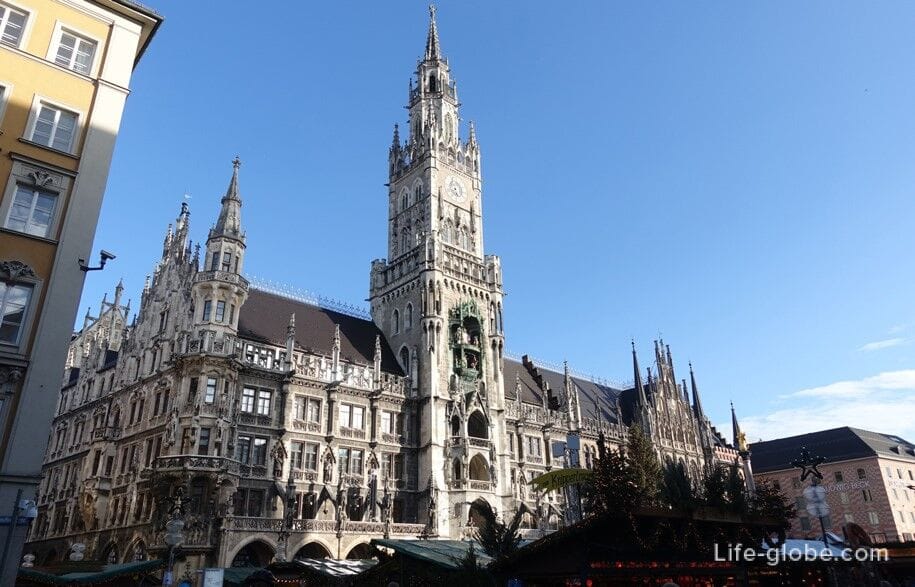
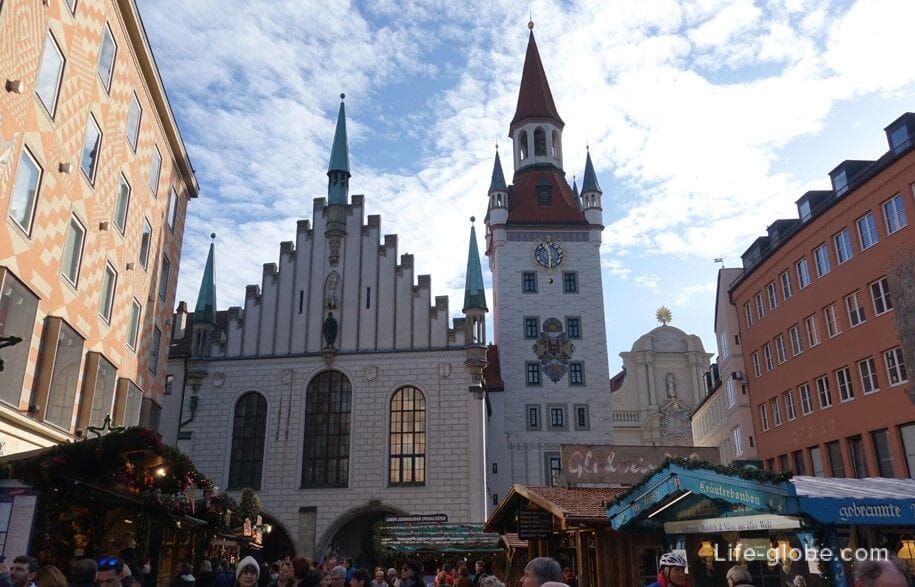
On Marienplatz, opposite the New Town Hall, is the Hotel BEYOND by Geisel, which offers views of the Old Town square. Link to the hotel
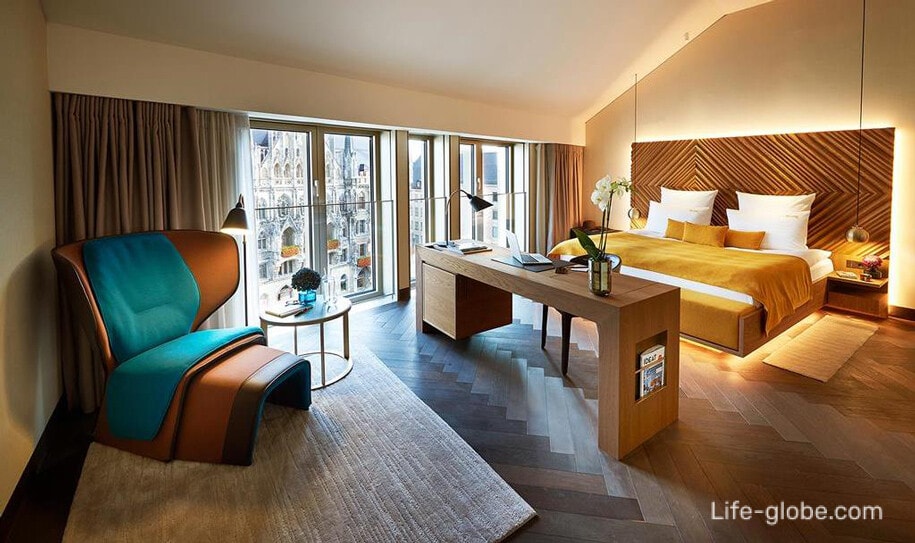
Frauenplatz
Frauenplatz is a small square, known primarily for the fact that its dominant feature is the main shrine of Munich - the Frauenkirche - the current cathedral of the Catholic Archdiocese of Munich and Freising, whose history dates back to 1468.
The church building is distinguished by two high towers-bell towers. At the top of the south tower is an observation deck, giving panoramic views of the city and the surrounding area. Read more about the Frauenkirche…
Also on the square is: fountain and cafe.
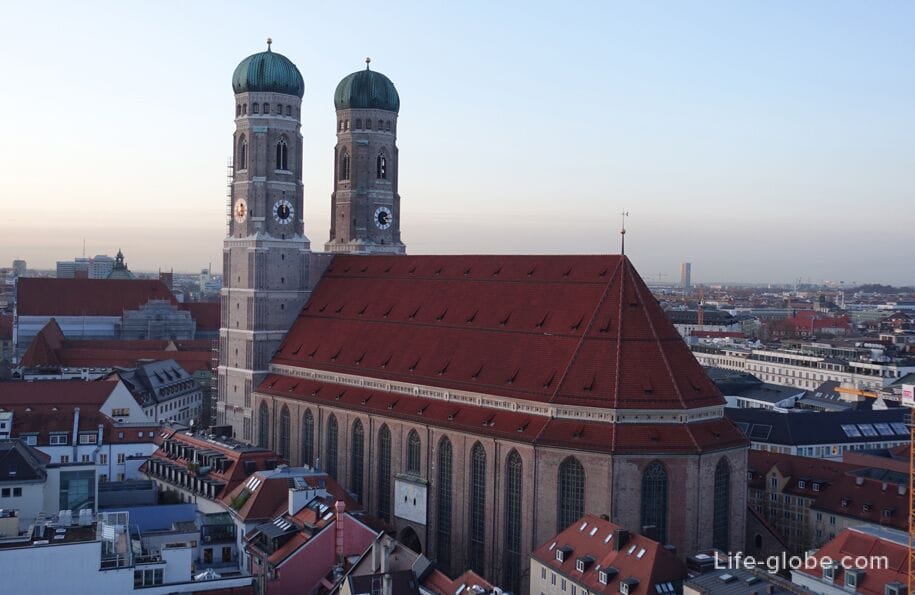
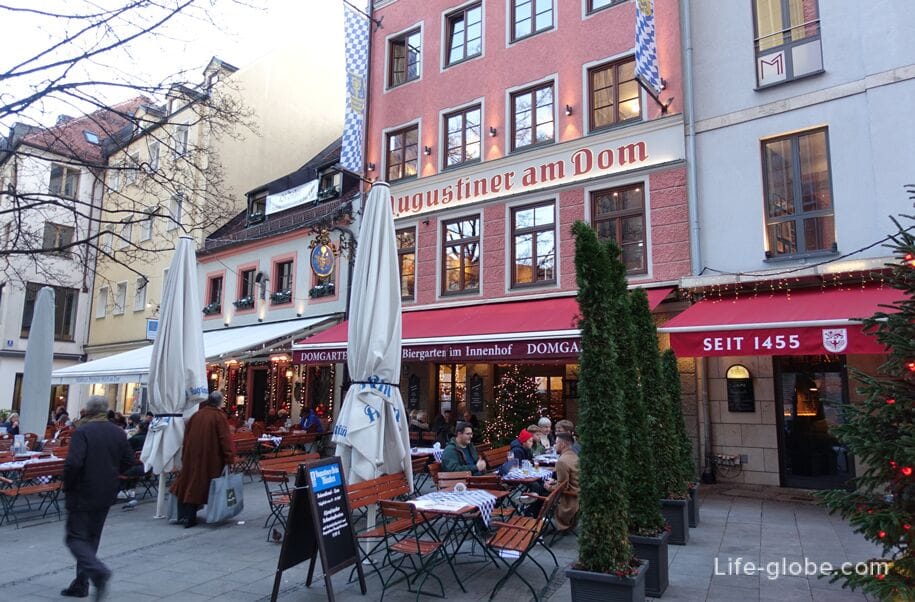
Max Joseph Square
Max Joseph Square was created in the early 19th century and named after the King of Bavaria - Maximilian I Joseph.
The center of the square is decorated with a monument to King Maximilian I (König Maximilian I Joseph von Bayern Denkmal), installed in 1835.
The north side of the Max-Josef-Platz is marked by the wing of the Munich Residence.
The south side of the square is dominated by the Palais Toerring-Jettenbach, built in the 18th century in the Rococo style.
On the west side of Max Joseph Square are the bright facades of historic middle-class houses (now restored).
In the eastern part of the square there are two theaters:
- The National Theater (Nationaltheater) is an opera house whose history dates back to 1811 and whose main appearance is formed by a wide staircase, a portico with eight Corinthian columns and a triangular two-level pediment with statues and paintings;
- The Residenz Theatre is a historic court theatre that was known as the Cuvillies-Theatre and was built in the immediate vicinity of the Munich Residence in 1751-1753. Read more about Max Joseph Square...
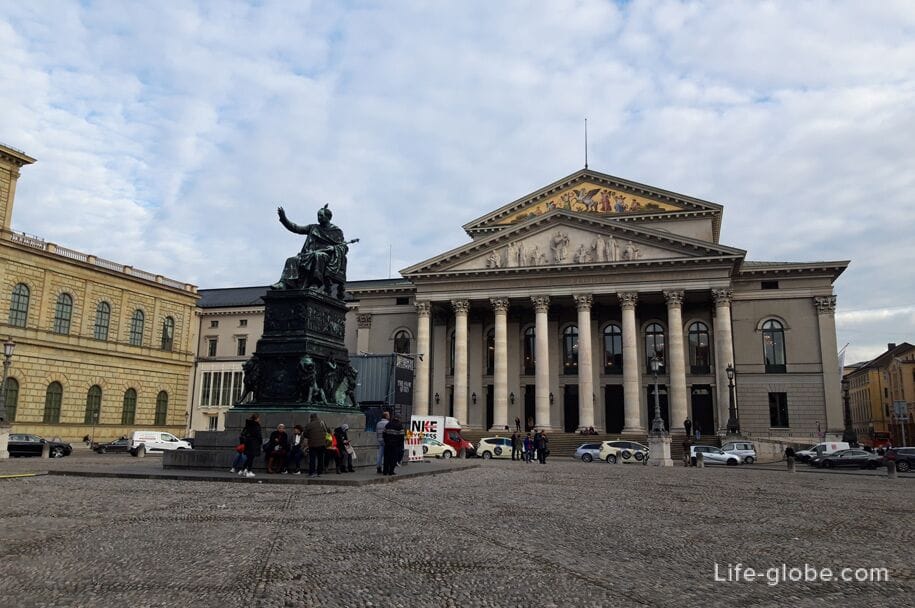
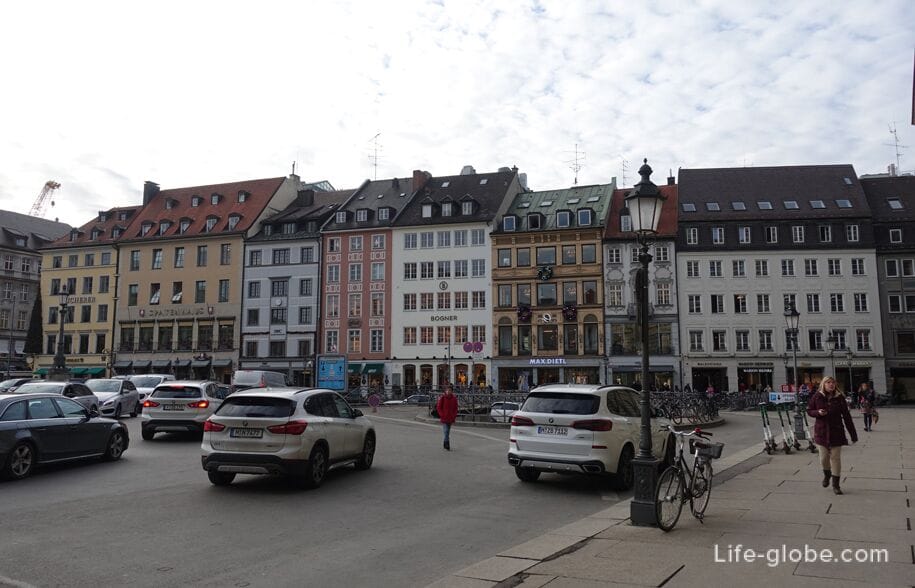
Odeonsplatz
Odeonsplatz is located on the northern edge of Munich's old town.
The foundation for the square was laid under King Maximilian I of Bavaria on the site of the city wall destroyed in 1791.
Odeonsplatz has such significant objects as:
- Feldherrnhalle - the so-called "Hall of the Bavarian Generals", which is a monumental loggia and monument built in the name of King Ludwig I in 1841-1844 to honor the glory of the Bavarian army and its victorious generals;
- St. Cajetan's Theatre Church (Theatinerkirche St. Kajetan), which is a Catholic church that was the court, cathedral, and order church of the Theatines.
The church was established in gratitude for the birth of the long - awaited heir to the Bavarian crown-Prince Max Emanuel in 1662;
- Moy Palace; Munich Residence wing; main entrance to the Hofgarten Park; Ludwig I Monument; commercial Bazaar building; former Odeon concert hall and Leuchtenberg Palace. Read more about Odeonsplatz…
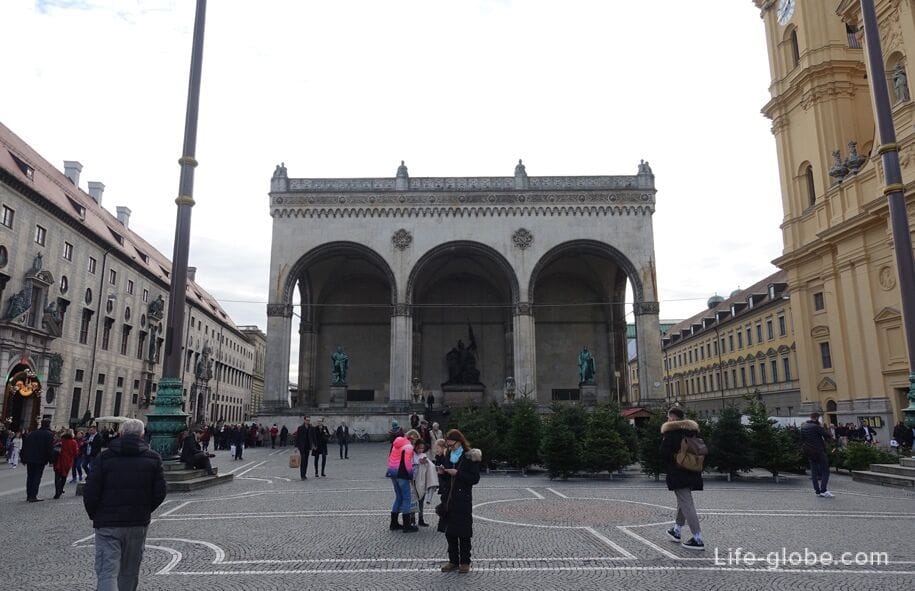
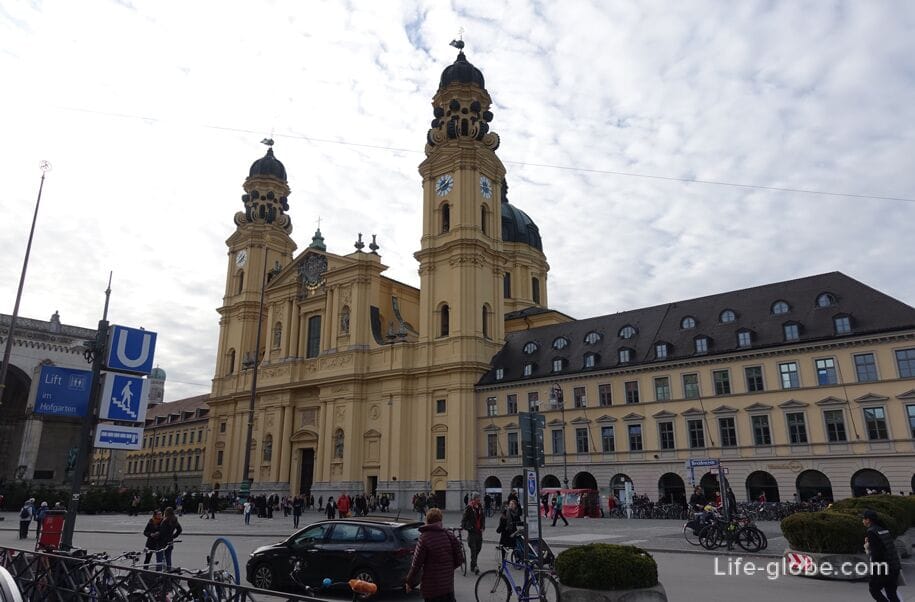
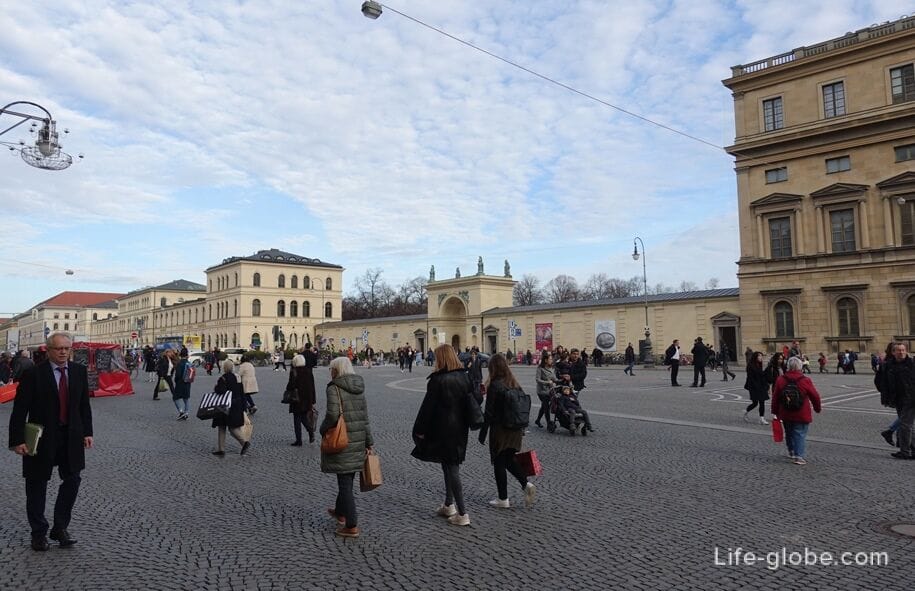
Platzl
Platzl is one of the most beautiful public squares in the historic part of Munich.
Platzl is a small pedestrian area of irregular shape, around which there are bright historical buildings - old townhouses, on the first floors of which today there are cafes and restaurants.
Platzl is notable for:
- The Hofbräuhaus is one of the oldest beer restaurants in Munich;
- Orlando House (Orlandohaus), built around 1900 and always used as a restaurant, tavern, or coffee shop. Read more about Platzl Square…
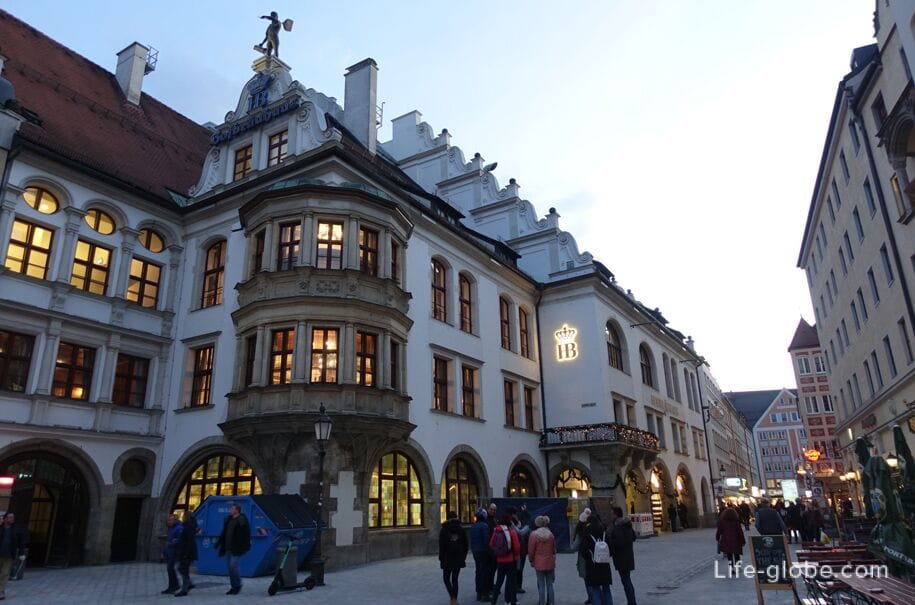

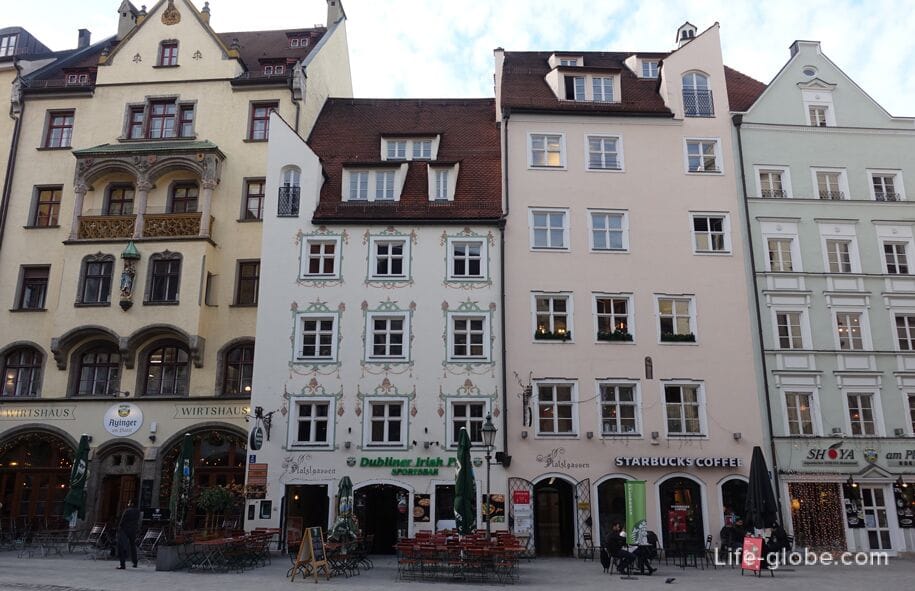
Karlsplatz
Karlsplatz is one of the most important squares in Munich.
Karlsplatz marks the western border of Munich's historic old town.
The dominant feature of the square is the Charles Gate (Karlstor), which is two small pseudo-Gothic towers connected by a bridge. The portals (passageways) in the gate are made in the form of three high pointed arches.
Also on the square is: a fountain, a department store and a shopping center. In the winter season, from about mid-November to mid-January, the square has an open-air ice rink. Read more about Karlsplatz…
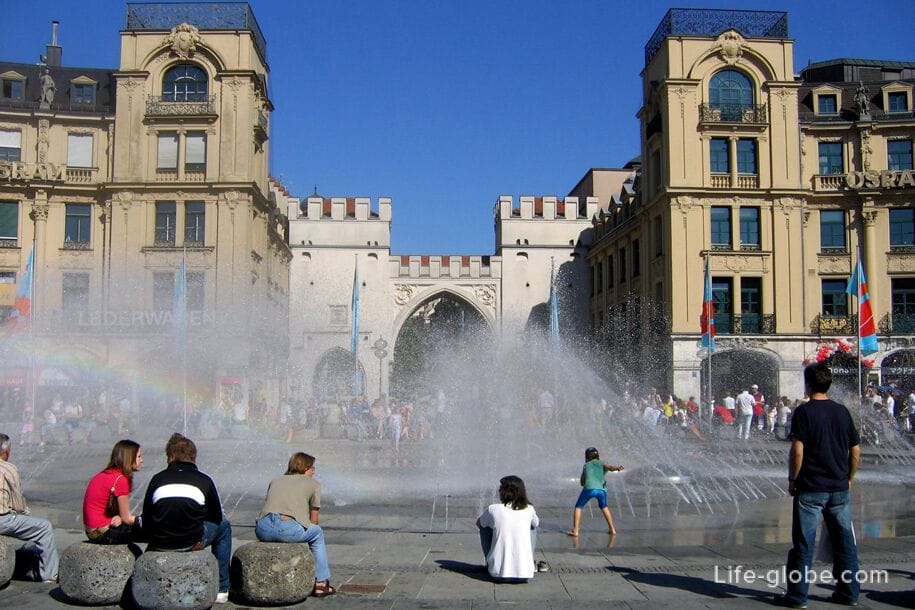
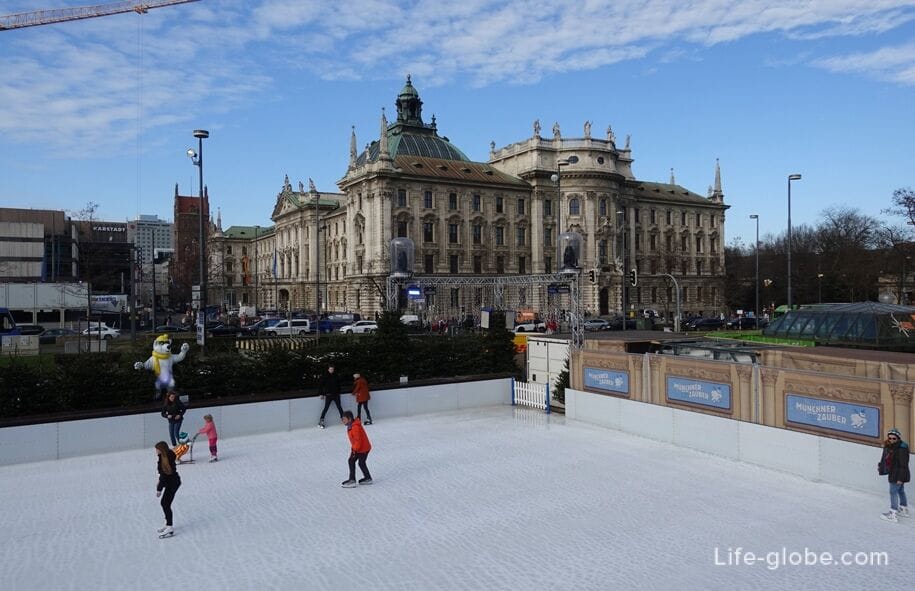
Lenbach Square
Lenbach Square (Lenbachplatz) is located on the western edge of the historic old town of Munich and is named after the Munich artist Franz von Lenbach.
On the western side of the square there are several buildings that represent an exquisite architectural ensemble.
Also on the square are notable:
- Munich House of Artists (Münchner Künstlerhaus), built from 1893 to 1900 in the Neo-Renaissance style;
- Maxburg Tower - the only remaining part of the former residence of Duke Maximilian Philip Hieronymus;
- Wittelsbach Fountain (Wittelsbacher Brunnen), built in 1893-1895 and is considered the most beautiful fountain in Munich. Read more about Lenbach Square…

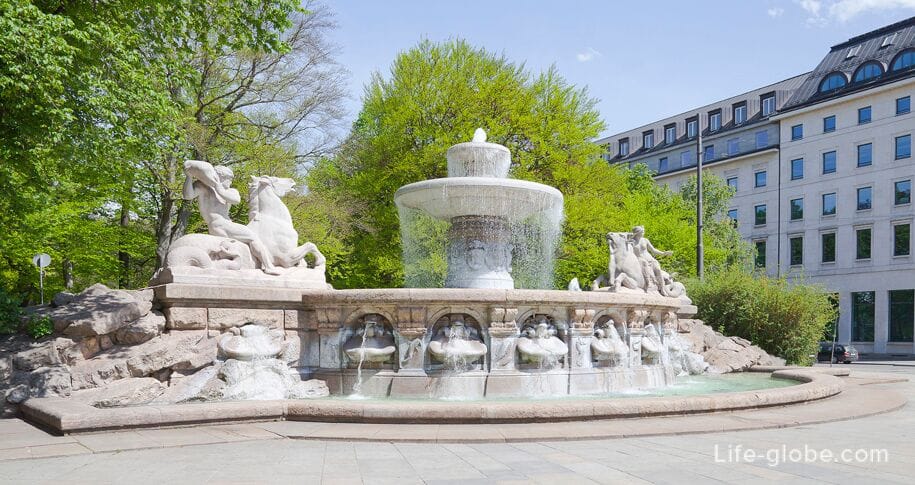
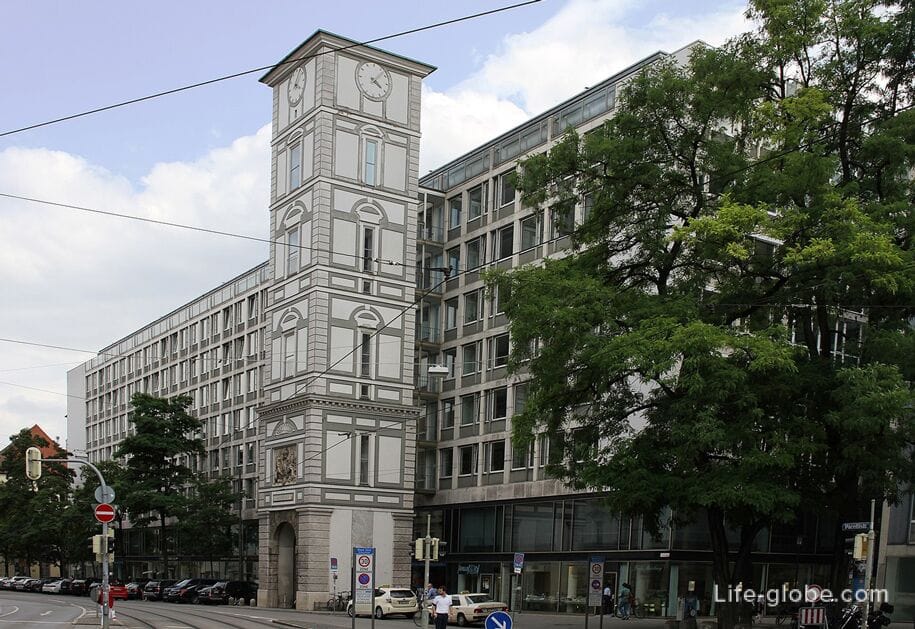
Maximiliansplatz
The Maximiliansplatz square was created after the demolition of the city's medieval fortifications and in accordance with the city's expansion plans.
The square is designed in the style of a miniature English garden and measures approximately 300 by 60 meters. The name" Maximiliansplatz " was given to the square around 1808, in honor of King Maximilian I. Previously, the square was known as the "Dultplatz".
Within the square are:
- Karl Amadeus Hartmann Fountain (Karl Albrecht Hof Brunnen);
- monuments to Max von Pettenkofer, Justus von Liebig, Karl Effner, Schiller and Goethe;
- Nornen Fountain (Nornenbrunnen), built in 1907 by Hubert Netzer in the Art Nouveau style;
- the building of the former luxury "Regina Palace Hotel", which existed from 1908 to 1975, and then was transformed into the" house of Regina " (Haus Regina) - an office building with restaurants. Address: Maximiliansplatz, 5;
- The Maxtor Gate is the youngest city gate in Munich, built in 1805, after the city wall was demolished on this site;
- fountain "Grotto" (Grottenbrunnen), located on the south side of Maxtor, in a niche near the corner walls of the houses numbered 18 and 19 on Maximiliansplatz. Read more about the Maxtor Gate and the Grotto Fountain…
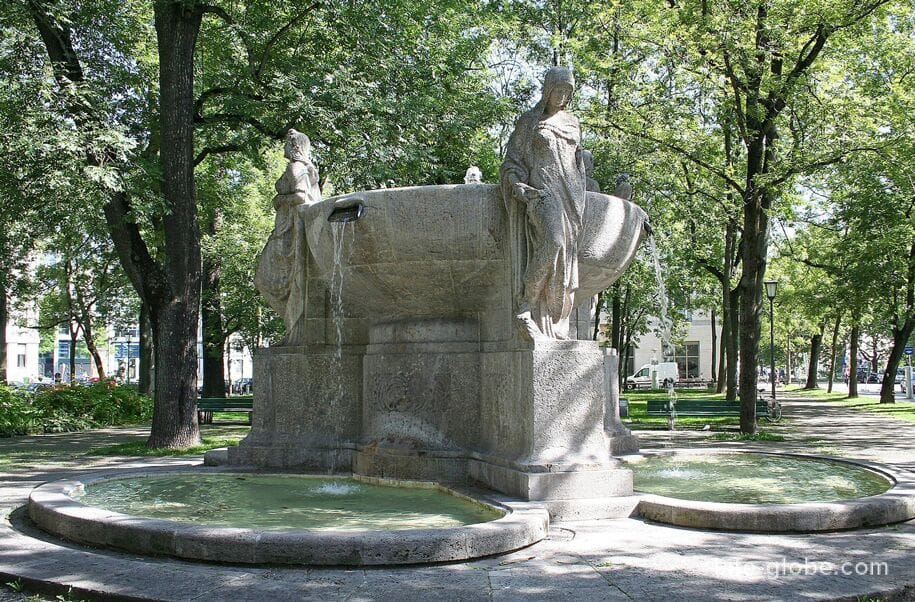
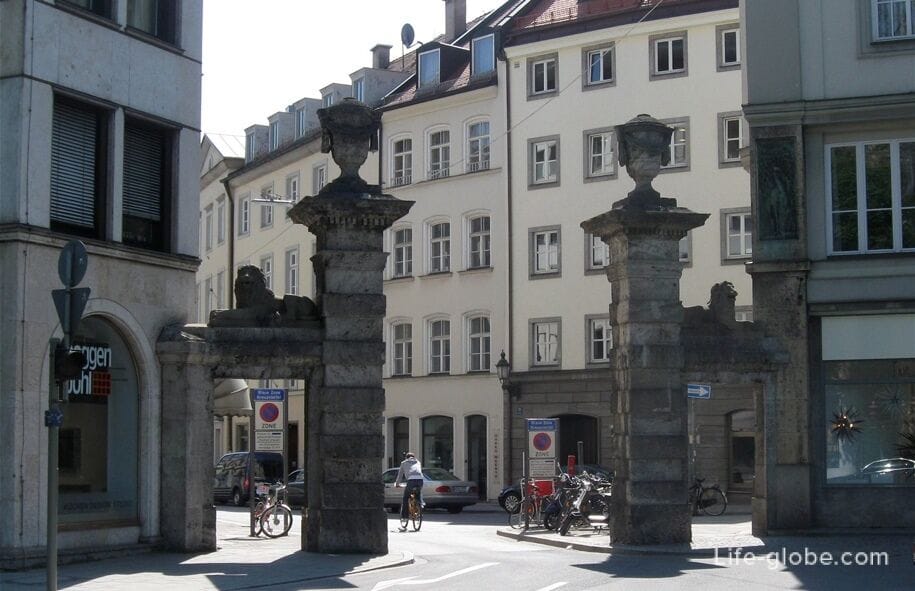
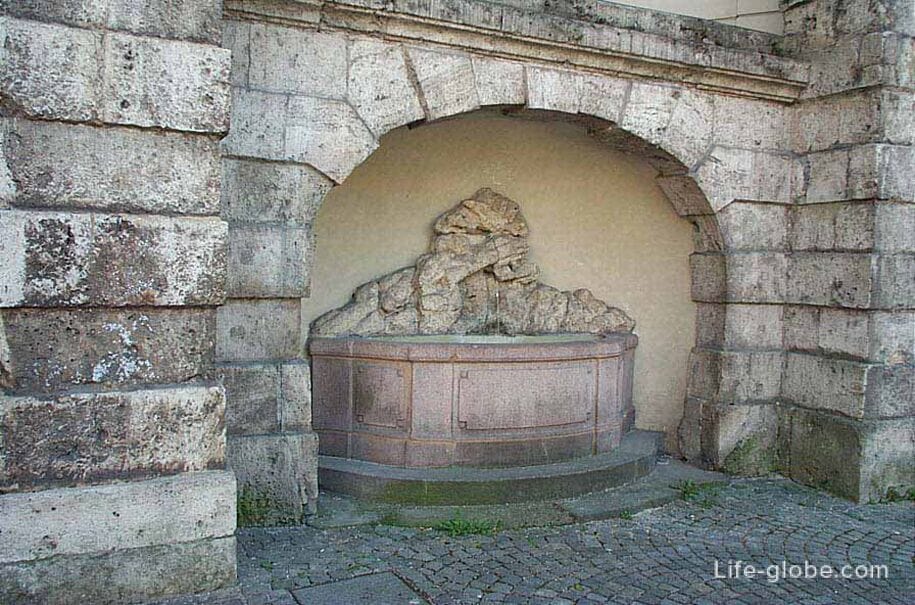
Promenadeplatz
The Promenadeplatz is a public square located in the northwestern part of the historic center of Munich.
In the center of the square there are significant monuments and statues, including: the monument to Count von Montgelas, which is more than 6 meters high and made of aluminum; the statue of Orlando di Lasso, which, since the end of June 2009 and to this day, is also a memorial and a place of pilgrimage for fans of pop musician Michael Jackson.
Historical buildings are located around the square: house Parkus (Parcus House); former Carmelite church; Gunetzreiner House (Gunetzrhainerhaus); Ballin House and historical 5-star hotel Bayerischer Hof, which includes the Palais Montgelas and the private Comedy theater in Bavaria Hof (Komödie im Bayerischen Hof). Read more about Promenadeplatz…
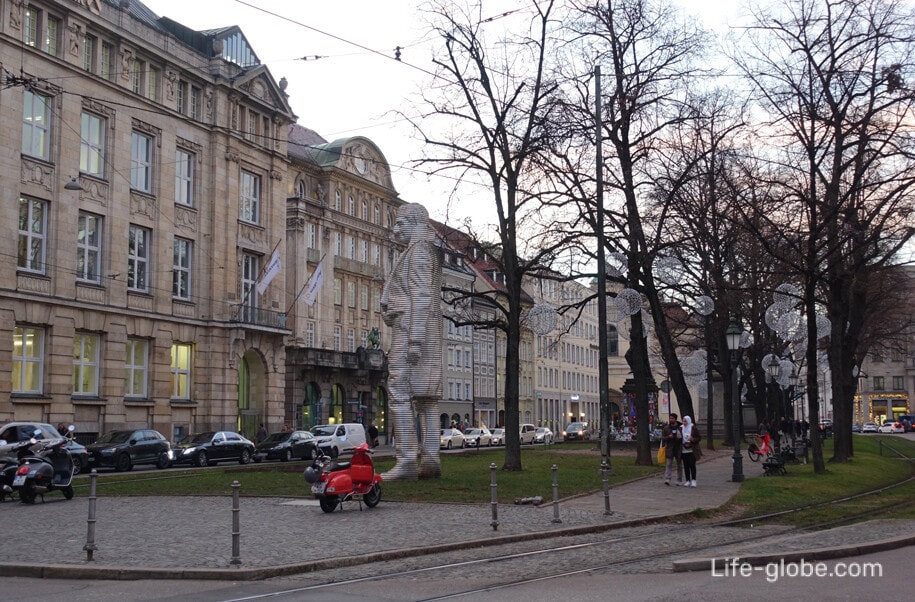
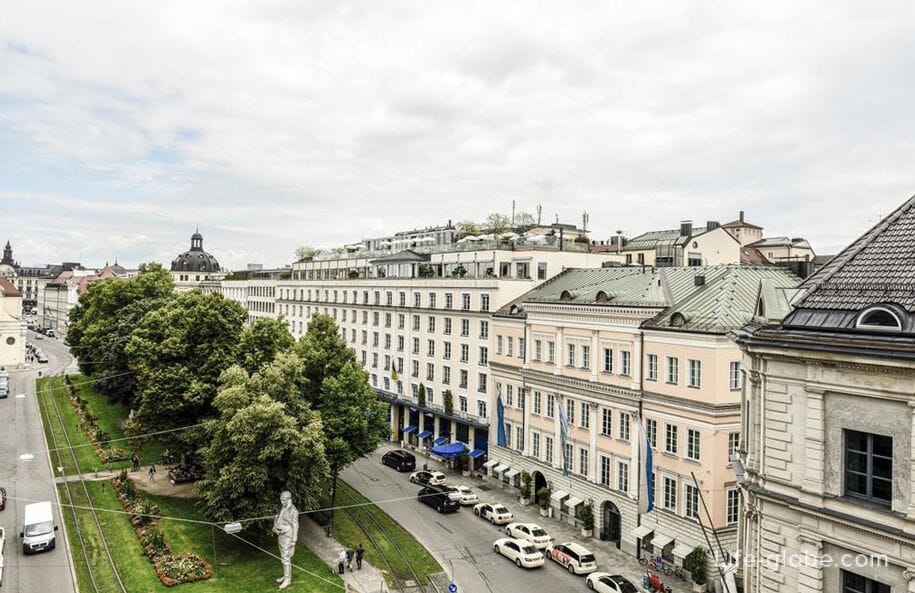
Rindermarkt
Rindermarkt is both a square and a street.
In the center of the square is the Rindermarkt fountain (Rindermarktbrunnen).
The north-eastern end of the Rindermarkt is marked by the church of St. Peter (Peterskirche), which dates back to the 11th century and in the bell tower of which there is an observation deck.
In the eastern part of the Rindermarkt is located Lion Tower (Löwenturm), which is an old structure and which was most likely built as a water tower for the city garden or a water disposal facility and was also used as a latrine tower. Read more about Rindermarkt…
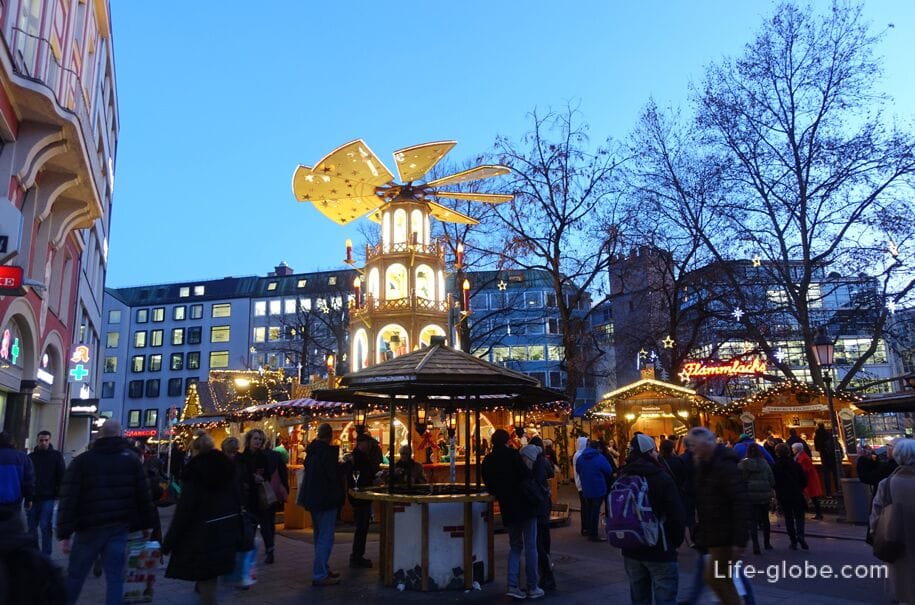
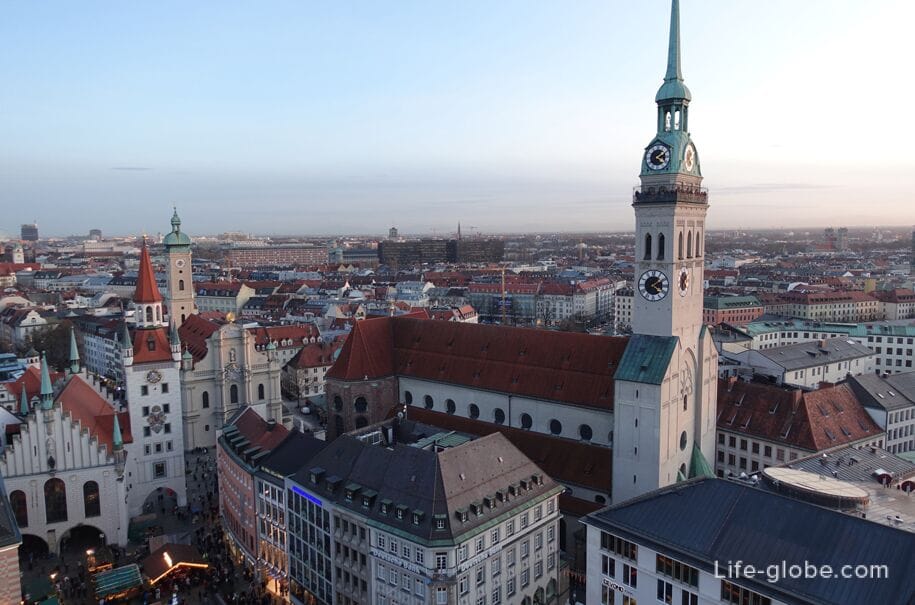
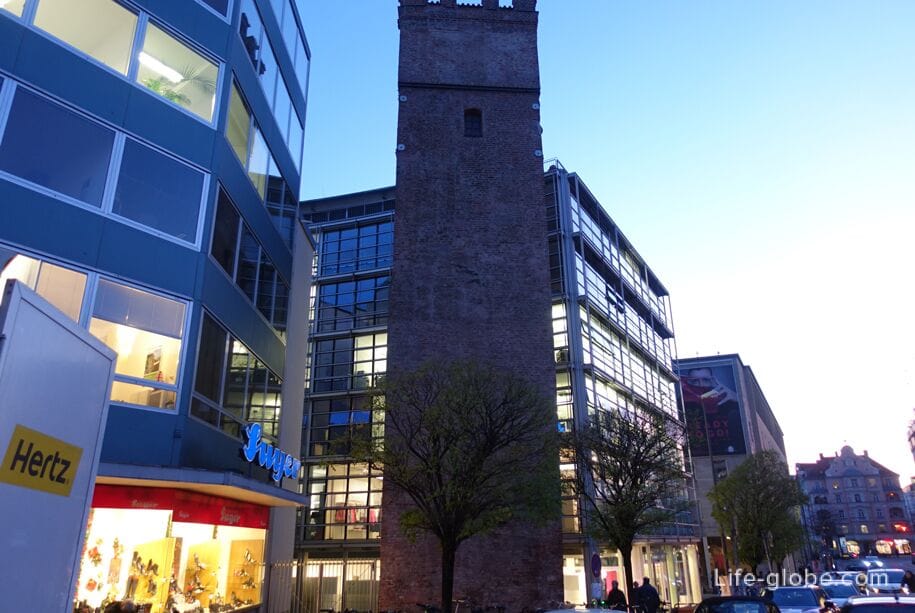
Sendling Gate Square
Sendling Gate Square (Sendlinger-Tor-Platz) is located near the southern edge of the old town and is famous for its Sendling Gate (Sendlinger Tor), which has a large central arch, two flanking towers with arched passages, and part of the inner wall.
The center of the square is decorated with a fountain.
Around the square are notable: the Filmtheater Sendlinger Tor cinema, which is more than 100 years old (was founded in 1913) and the Evangelical Church of St. Matthew (Lutheran Church of St. Matthew).
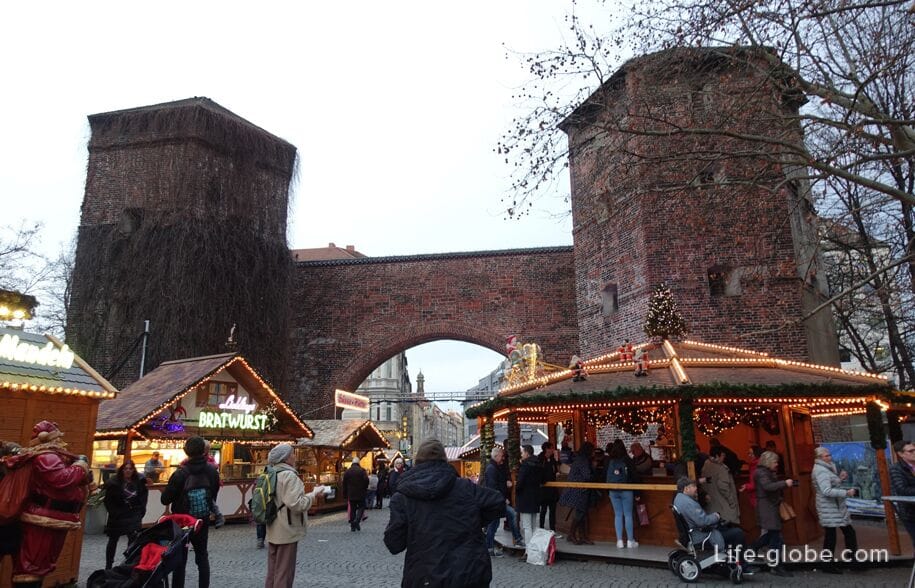

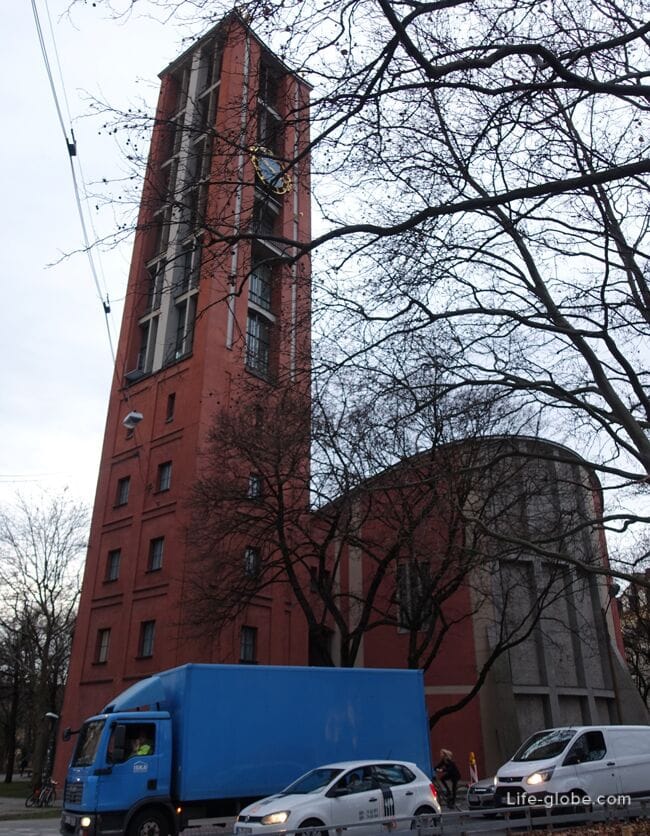
St. James' Square
St. James' Square (Sankt-Jakobs-Platz) is located in the south-eastern part of the historic old town and today is restricted from traffic.
On the square there are:
- places to relax, fountain;
- the Jewish center complex, which is an architectural ensemble consisting of three independent buildings located near each other: the new synagogue Ohel Jacob, the community center of the Jewish cultural community of Munich and Upper Bavaria, the Munich Jewish Museum;
- Munich City Museum (Münchner Stadtmuseum) with the Museum of the History of Cinema (Filmmuseum);
- ORAG house (ORAG-Haus) - a historic building with bay windows, paintings and stucco on the walls;
- Ignaz-Günther-Haus - a four-story narrow building with a gable mansard roof;
- Church of St. Jacob on Anger (Kath. Kirche St. Jakob am Anger), dating back to the 13th century. Read more about St. James ' Square…
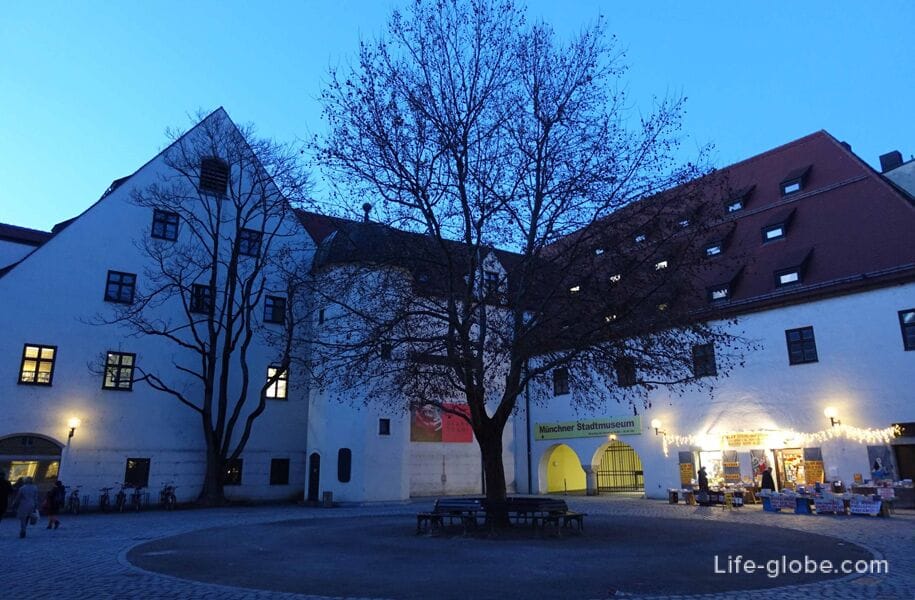
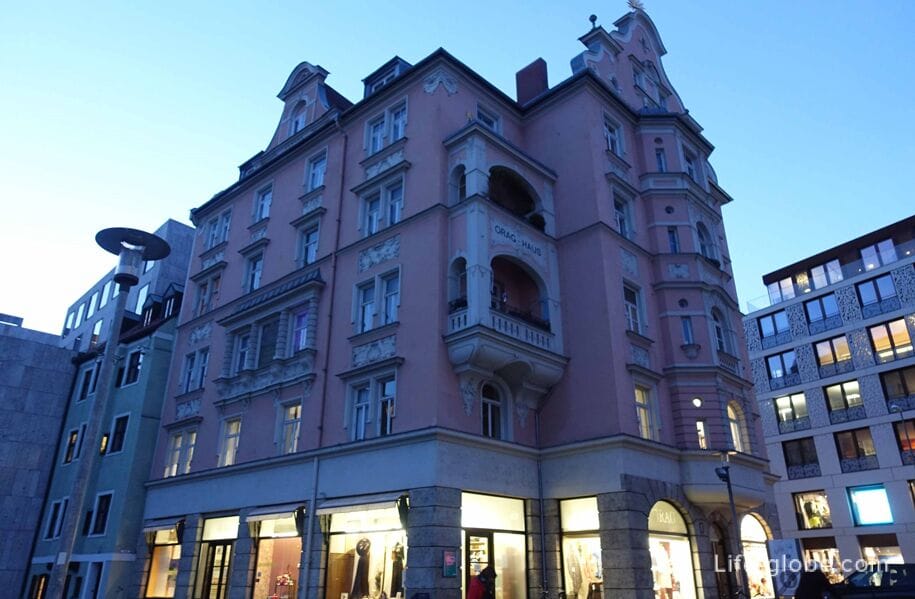
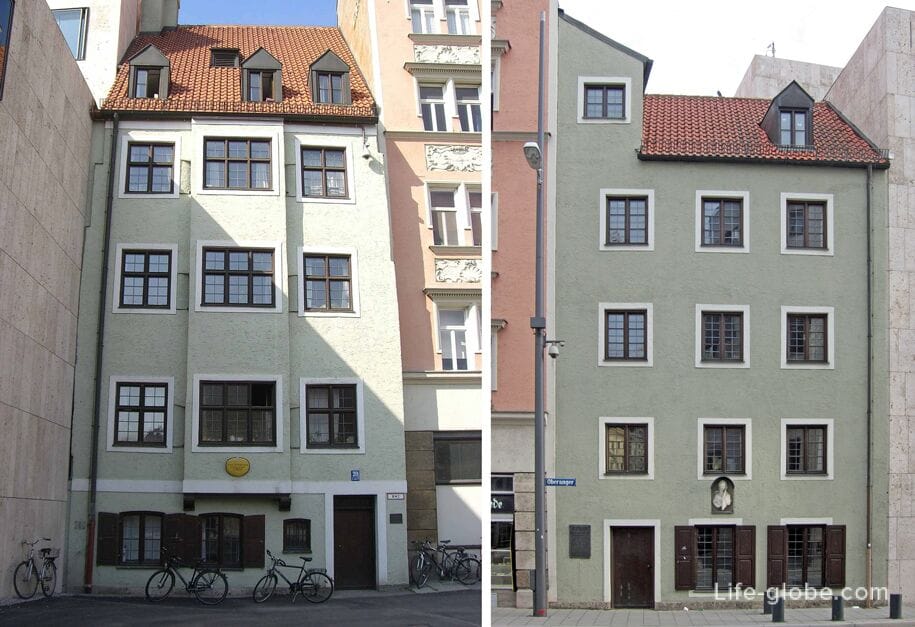
Sebastian Square
Sebastian Square (Sebastiansplatz), more like a small street, is located near St. James ' Square.
The north side of the square is characterized by 3-and 4-storey buildings-former townhouses (Neo-Renaissance structure), some of which have survived to this day and mostly date back to 1761-1890.
It is the oldest enclosed row of houses in Munich. Read more about Sebastian Square…
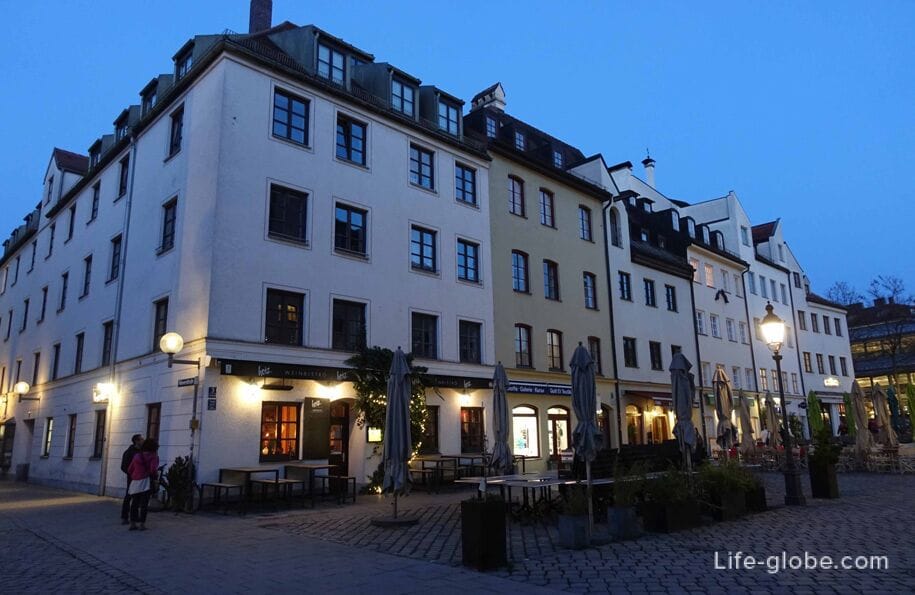
Squares in the Maxforstadt district
The Maxvorstadt district is located in the center of Munich and is known primarily as a place of culture and science. Within its borders are some of the most famous museums in Munich (Area of art), as well as theaters, government agencies, educational and research institutions. Read more about the Maxforstadt district…
Royal Square
The Royal Square (Königsplatz) was created in the style of European neoclassicism in the 19th century by the German court architect Leo von Klenze by decree of Crown Prince Ludwig I of Bavaria as a "Place of Culture".
On the Royal Square there are:
- Propylaea (Propyläen) - a historical monument, which is a former gate (front passage), erected in 1862.
- museums: Glyptoteca and State Antique Collection. Read more about the Royal Square…
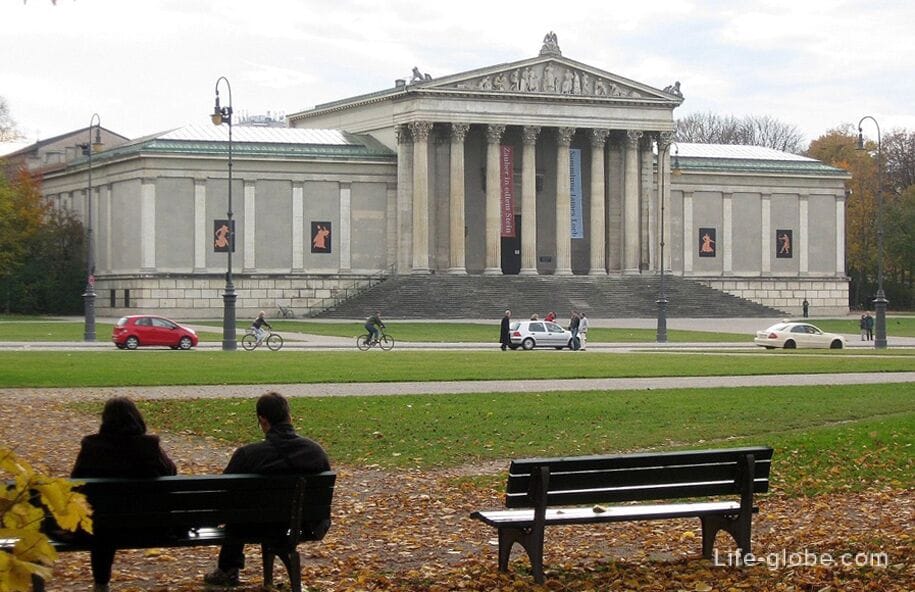
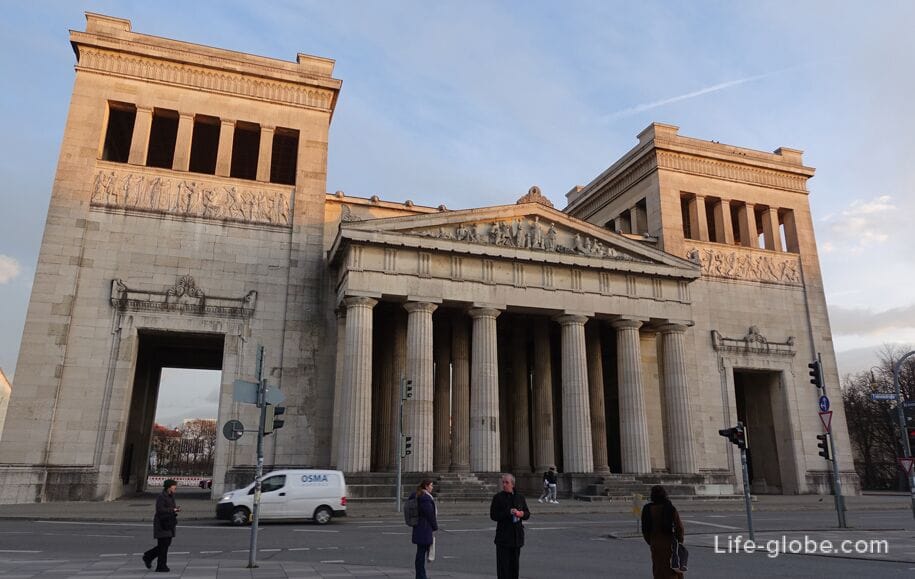
Wittelsbach Square
Wittelsbach Square (Wittelsbacherplatz) is the most beautiful classicist square in Munich.
The square received its current name in 1827, when it was named after one of the oldest noble families - the Wittelsbachs.
The center of the square is decorated with a bronze equestrian statue of Elector Maximilian I, and around the square are concentrated historical buildings, including former palaces. Read more about Wittelsbach Square…

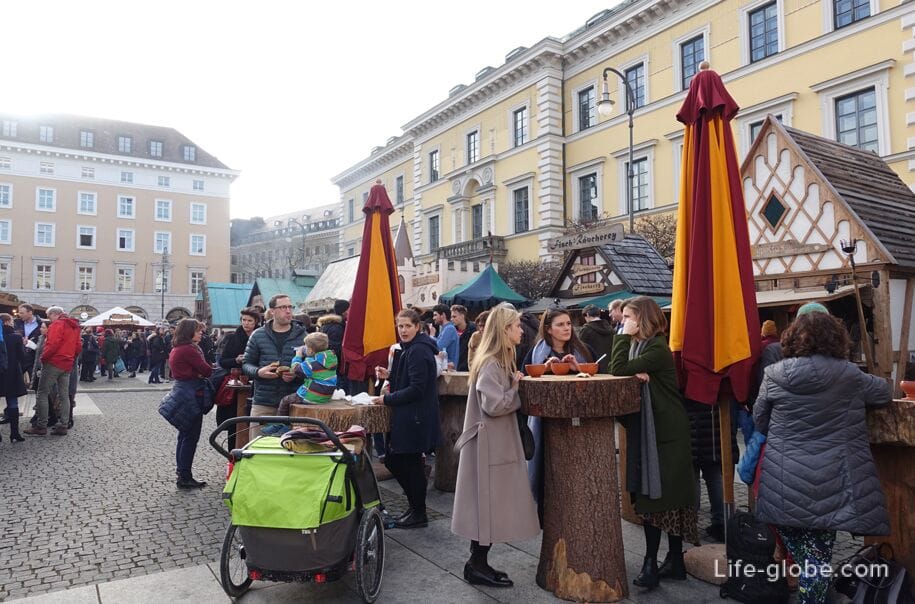
Karolinenplatz
Karolinenplatz square was erected by analogy with the Parisian square of the Stars and named after the second wife of King Maximilian I - Princess Caroline of Baden.
The square is known primarily for its 29-meter-high obelisk, which rises in the very center of the square and is called "Obelisk on Karolinenplatz" (Obelisk am Karolinenplatz).
The obelisk was erected in 1833 as a memorial to the soldiers of the Bavarian army who died in the Russian campaign of Napoleon in 1812. Read more about Karolinenplatz and the obelisk…
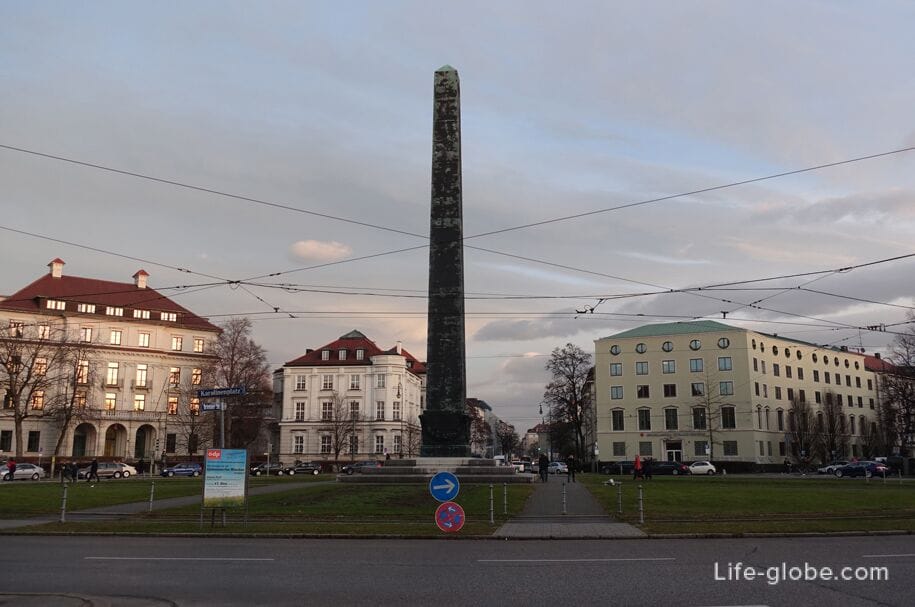
Squares in the Lehel district
Lehel is a former small district of Munich, located on the west side of the Isar River and today part of the Altstadt-Lehel district. Read more about Altstadt-Lehel…
St. Anne's Square
St. Anna's Square (St.-Anna-Platz) is considered the center of Leel and was created in the late 19th century as part of the construction of the new parish church of St. Anna (Pfarrkirche St. Anna).
The Church of St. Anne, located in the center of the square, was built in the neo-Romanesque style in 1887-1892.
This church is considered one of the best examples of historicism in Munich.
Inside the church, the apse fresco above the main altar, created by the German artist and craftsman Rudolf von Seitz, is noteworthy.

Mariannenplatz
Mariannenplatz is a small square located near the Isar River.
In the center of the square is the Church of St. Luke (St. Lukas, Lukaskirche) - the largest Protestant church in Munich, which is the only almost completely preserved Lutheran church in the historical part of the city.
The shrine was erected in 1893-1896.
Today, this majestic and, without a doubt, architecturally refined building attracts attention mainly with its Romanesque features, two high towers facing the river and a large dome.
The interior of the church is based on the early Gothic style. Read more about St. Luke's Church…
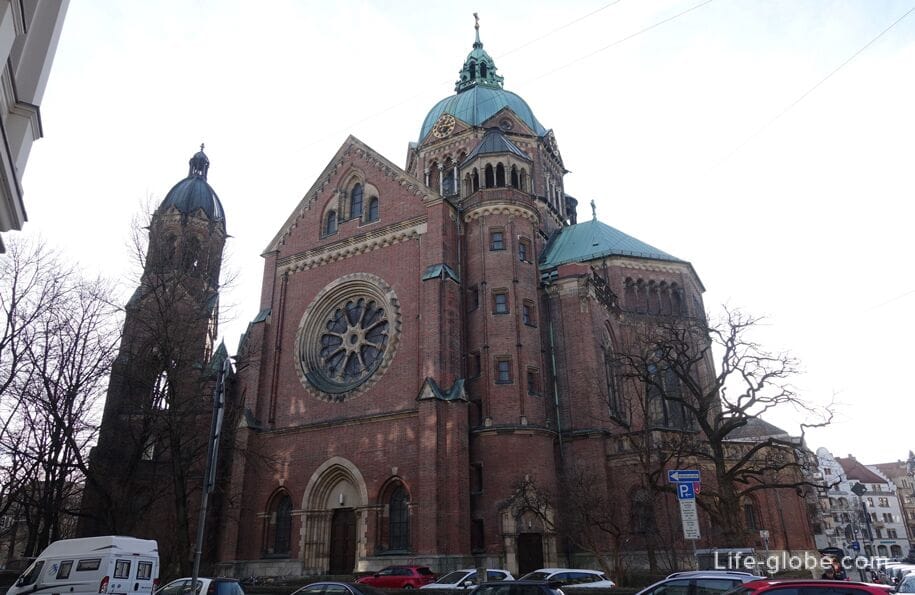
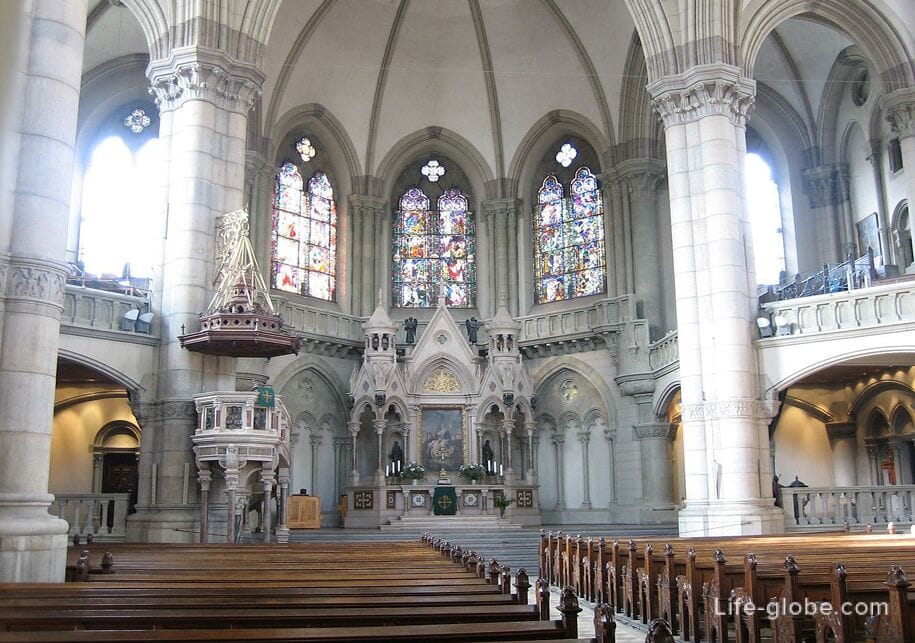
Squares in the Au-Haidhausen district
The Au-Haidhausen district is located on the east side of the River Isar and was originally a place of residence and work for artisans, small businesses, labourers and day laborers outside the medieval city walls of Munich. Read more about the Au-Heidhausen district…
Vienna Square
Vienna Square (Wiener Platz) is the most attractive square in the district and, from 1889 to the present day, there is a small permanent food market. The market in the square is open every day except Sunday.
Also notable on the square are historical buildings, restaurant "Hofbräukeller" with a beer garden and the Fischerbuberl-Brunnen fountain, in the upper central part of which a naked boy in a panama hat is depicted standing on a ball and holding a fish in each hand. Read more about Vienna Square…
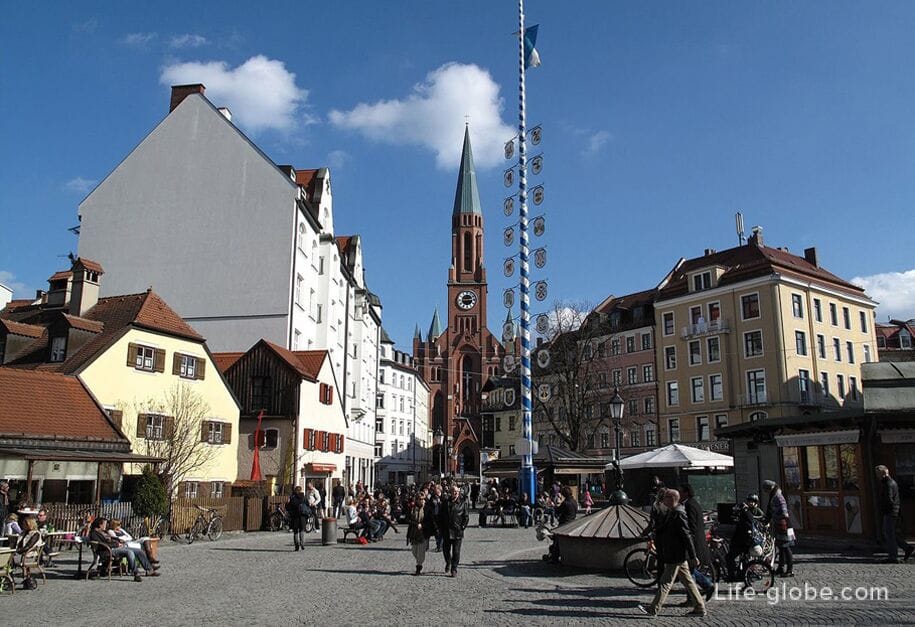
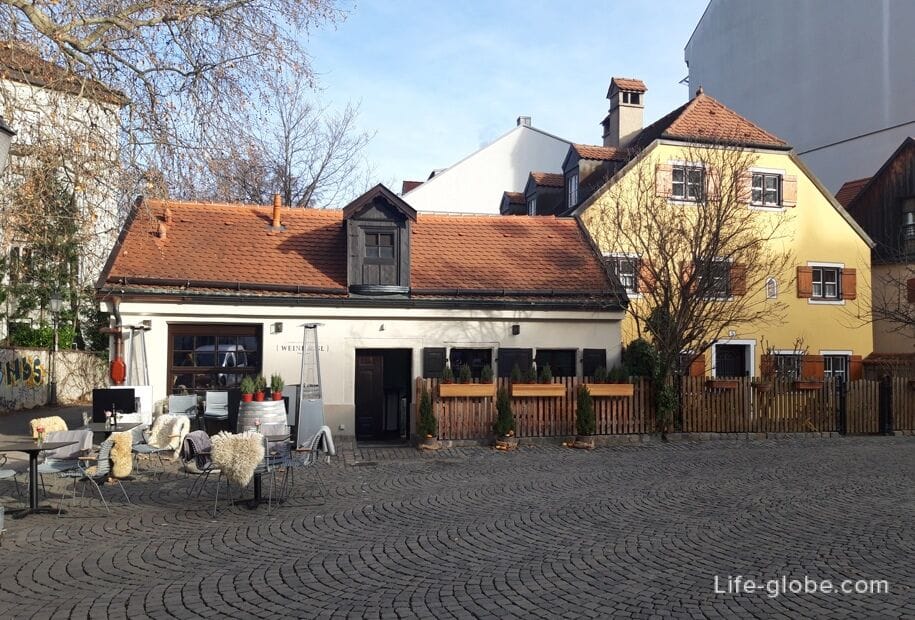
Weissenburger Square
The Weissenburger Square (Weißenburger Platz) forms the center of the so-called "French Quarter", which was created in 1872 after the German victory in the Franco-Prussian war (1870-1871).
In the center of the square is the "glass palace fountain" (Glaspalastbrunnen), created by August Voight in 1853. The fountain was once located in the Glass Palace (now defunct) in the old botanical Garden in the Maxforstadt district, but was later moved to its current location.
In the warm season, flowers are planted on the square, and guests and locals relax on the benches. On Christmas Eve, there is a small and cozy Christmas market in the square.
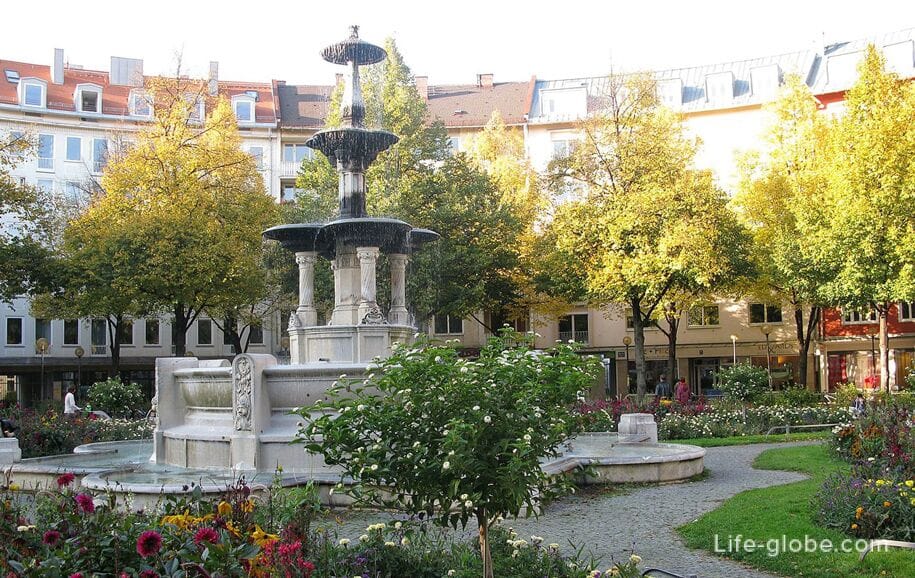
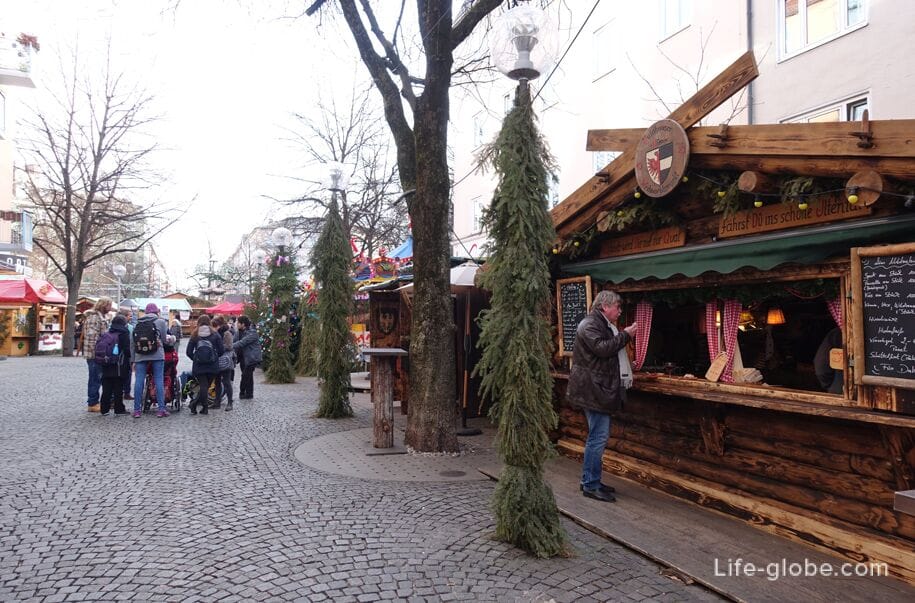
Marijahilfplatz Square
Square Mariahilfplatz is famous primarily for the fact that three times a year it hosts one of the largest traditional fairs in Munich - "Auer Dult: in spring in May (Mai-Dult), in summer in July or early August (Jakobi-Dult) and in autumn in October (Kirchweih-Dult).
The center of the Mariahilfplatz is dominated by the neo-Gothic parish Catholic church Mariahilf (Mariahilfkirche), which is considered an example of a 19th-century neo-Gothic church building.
The construction of the church was carried out from 1831 to 1839. The church has a high tower, reaching 93 meters. There is an organ in the church.
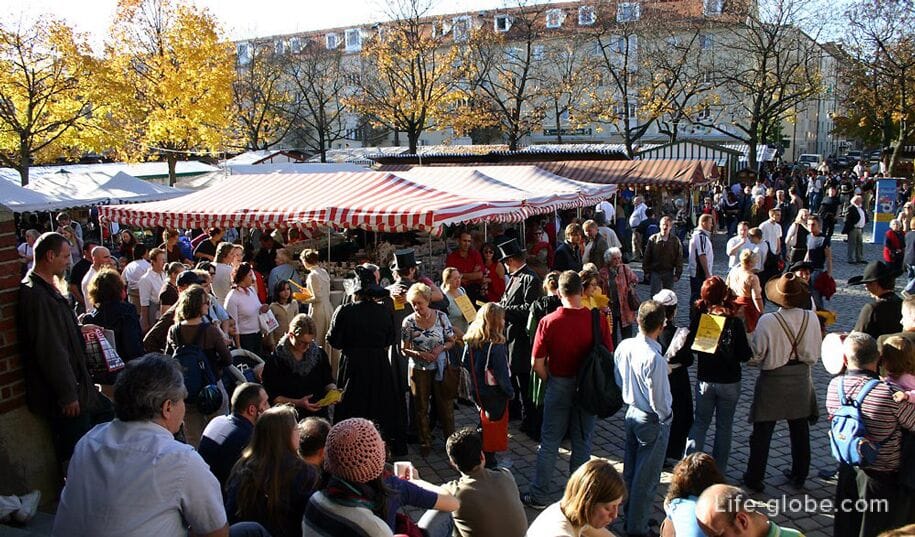
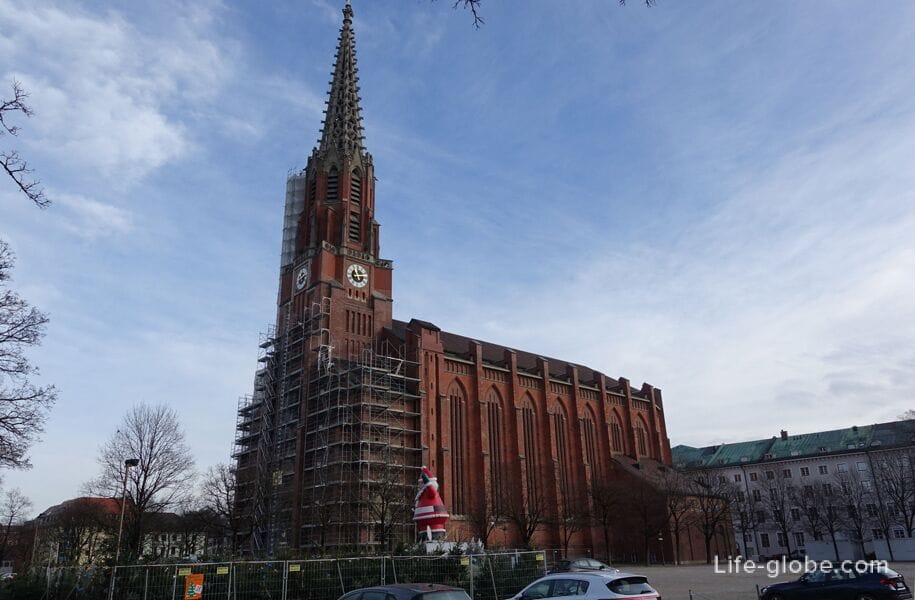
Squares in the Bogenhausen district
The Bogenhausen district is located on the east side of the Isar River.
Bogenhausen has long been a suburb and a place where several palaces were located, and then wealthy citizens built their villas. Read more about the Bogenhausen district…
Prinzregentenplatz
Prinzregentenplatz square is the western extension of Prinzregentenstrasse (Prinzregentenstraße) - one of the main streets of Munich, which is one of the four royal avenues of the city (city boulevards).
The square is dominated by The Prince Regent Theater (Prinzregententheater), built of cast stone between 1900 and 1901.
Also notable on the square are : houses of the Grunder era, a fountain installed in the center of the square and a small square that is decorated with a monument-memorial to the composer Richard Wagner (Richard-Wagner-Denkmal).
The house at number 16 on Prince Regent Square was the apartment of Adolf Hitler, now the police station is located in this building.
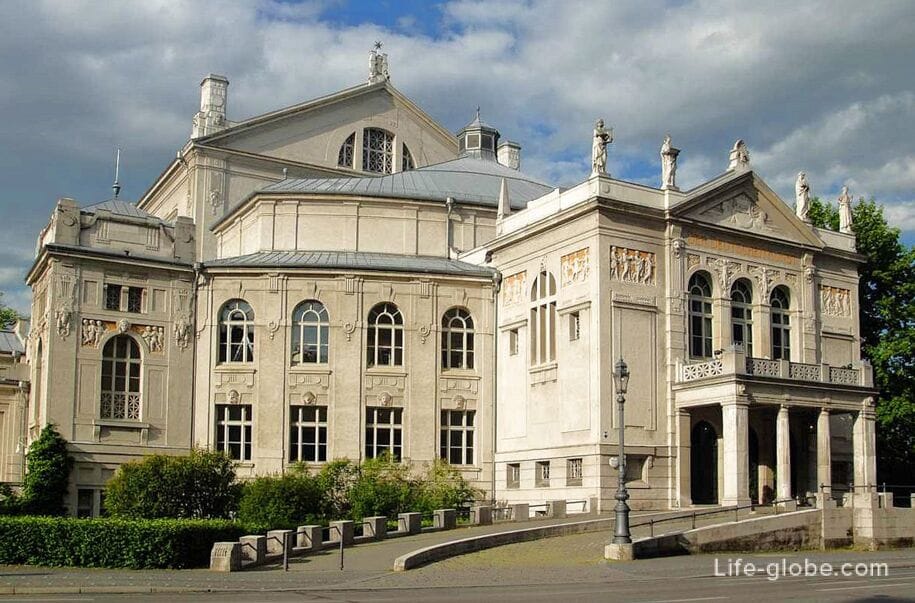
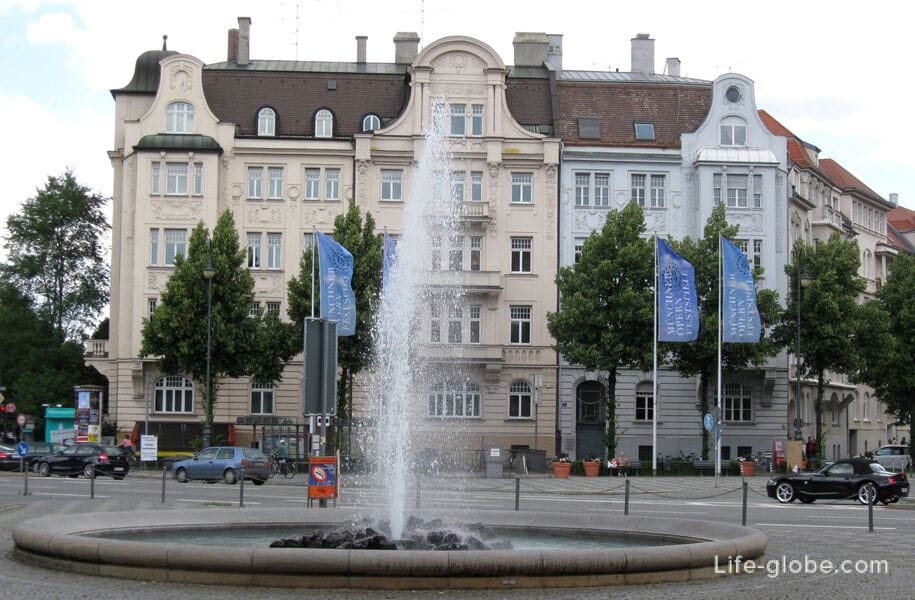
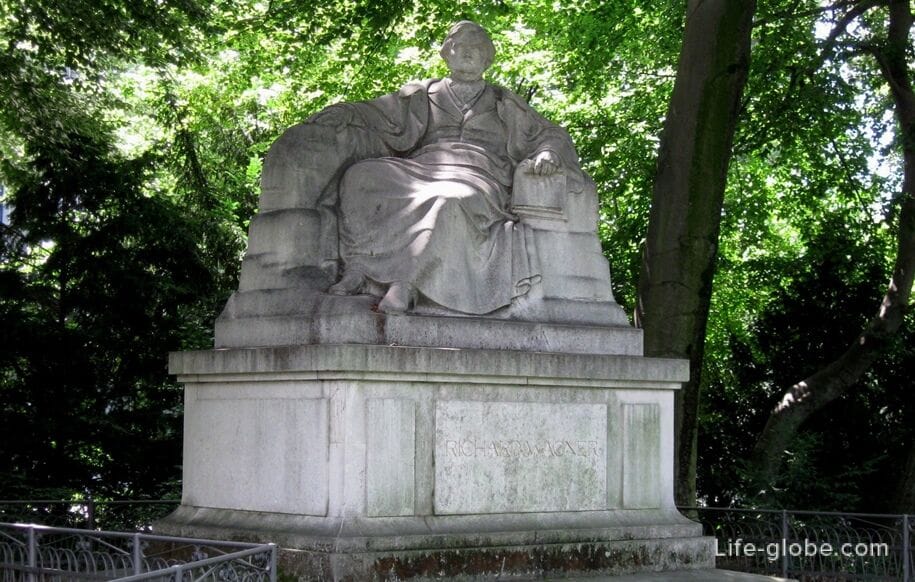
Effnerplatz
Effnerplatz Square is a transport hub, but it is notable for the fact that it houses the sculpture "Mae West" (Mae West) - an art object with a height of 52 meters, created by the American installation artist and sculptor Rita McBride.
The sculpture is a rod structure made of pipes in the form of a hyperboloid, in which, with a lot of imagination, you can see the Hollywood star Mary Jane West in a figure-hugging long dress.
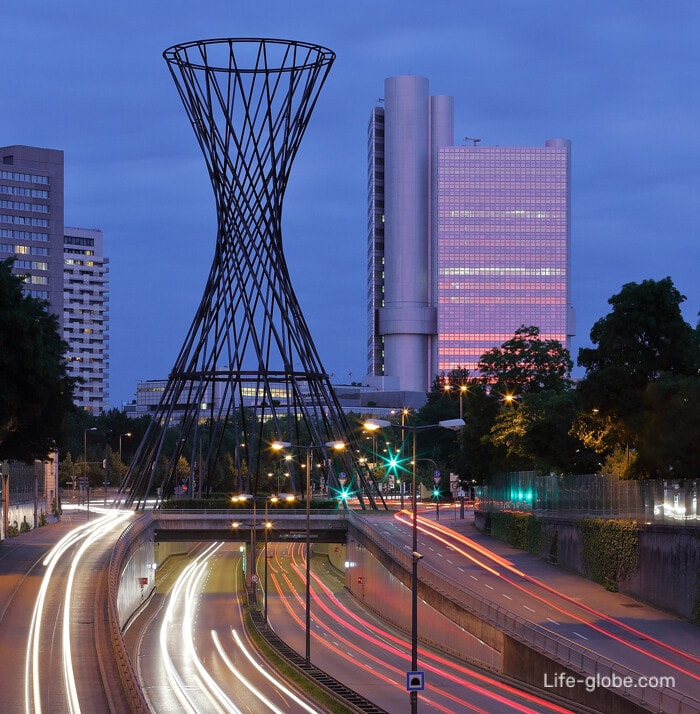
Squares in the Ludwigsforstadt-Isarforstadt district
The Ludwigsvorstadt-Isarvorstadt district is located on the west side of the Isar River and is adjacent to the Old town of Munich on the north side.
The district is famous, first of all, for the fact that Theresa's Meadow, which is the largest venue in Munich for celebrations and festivals, including:
- the world's most famous and largest folk festival (beer festival) - Oktoberfest;
- the winter festival "Tollwood", which includes a Christmas market and cultural events that last until the New Year. Read more about the Ludwigsforstadt-Isarforstadt district…
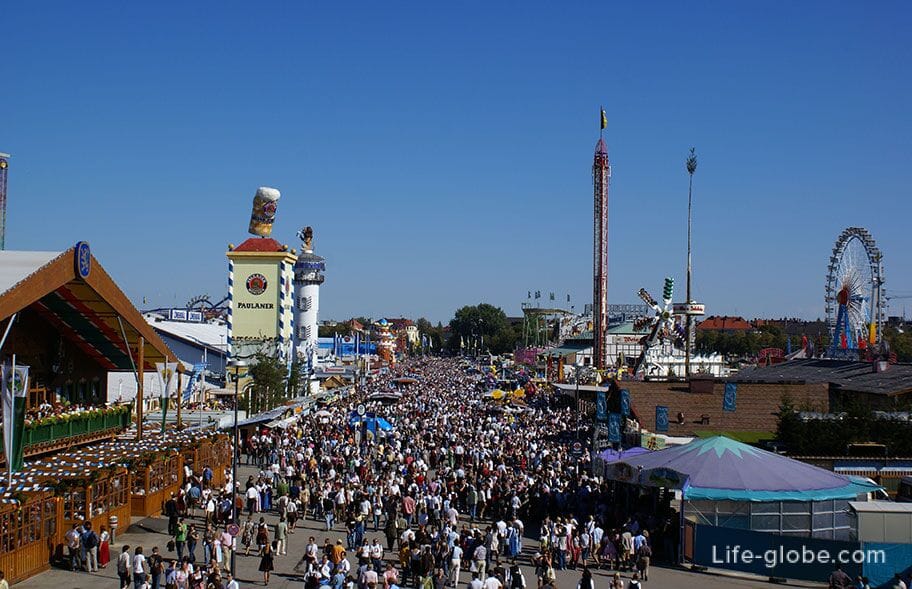
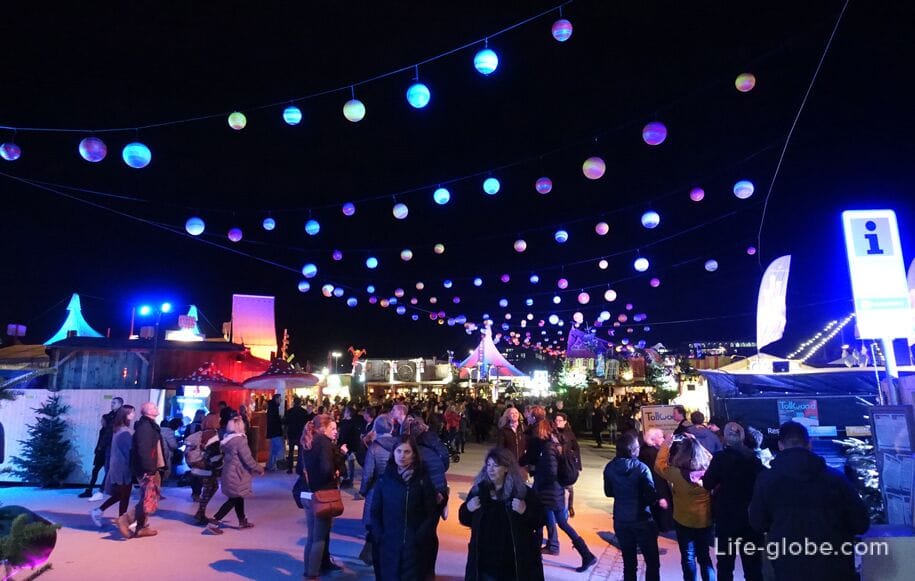
Gertner Square
The Round Gertner Square (Gärtnerplatz) was built around 1860 and named after the German architect Friedrich von Gertner.
In 1865, in the southern part of the square was erected theater on Gärtnerplatz (Staatstheater am Gärtnerplatz) in the late classical style, which still forms the appearance of the square.
In the center of Gertner Square are: the Schalenbrunnen fountain, a monument to the architect Leo von Klenze (1784-1864), flower beds and places to relax.
In the buildings around the square there are retail premises, cafes and restaurants.
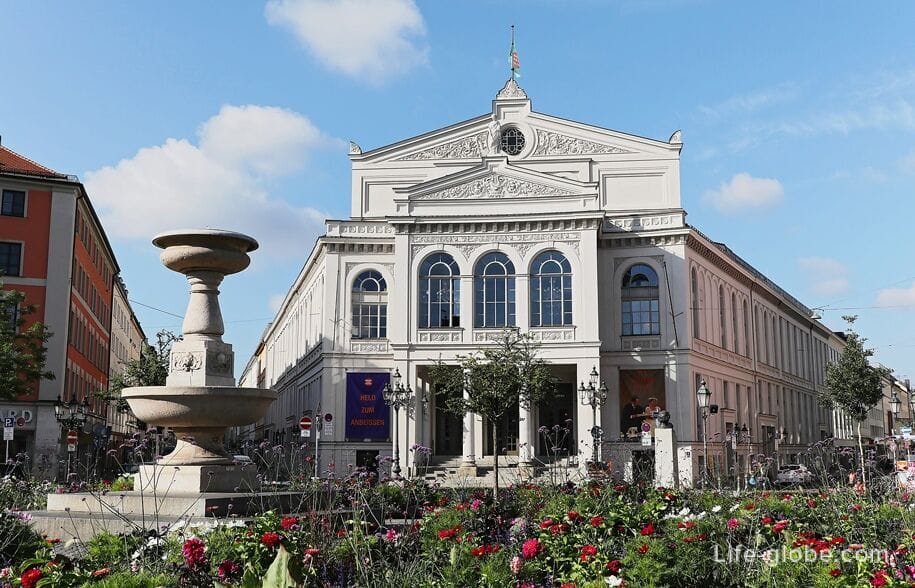
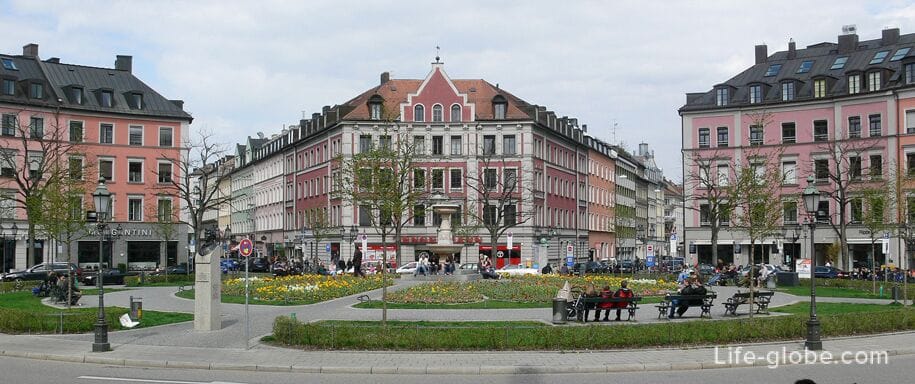
St. Paul's Square
St. Paul's Square (St.-Pauls-Platz) is a small square, attractive because it is dominated by the Catholic Church of St. Paul (Kirche St. Paul, Paulskirche), built between 1892 and 1906 in the neo-Gothic style.
Special attention is drawn to the church by the high main tower, which rises to the sky at 97 meters and at the top of which there is a circular observation deck with views of the Therese Meadow, the center of Munich and the surrounding area. The site is open to visitors during the Oktoberfest. Read more about St. Paul's Church...
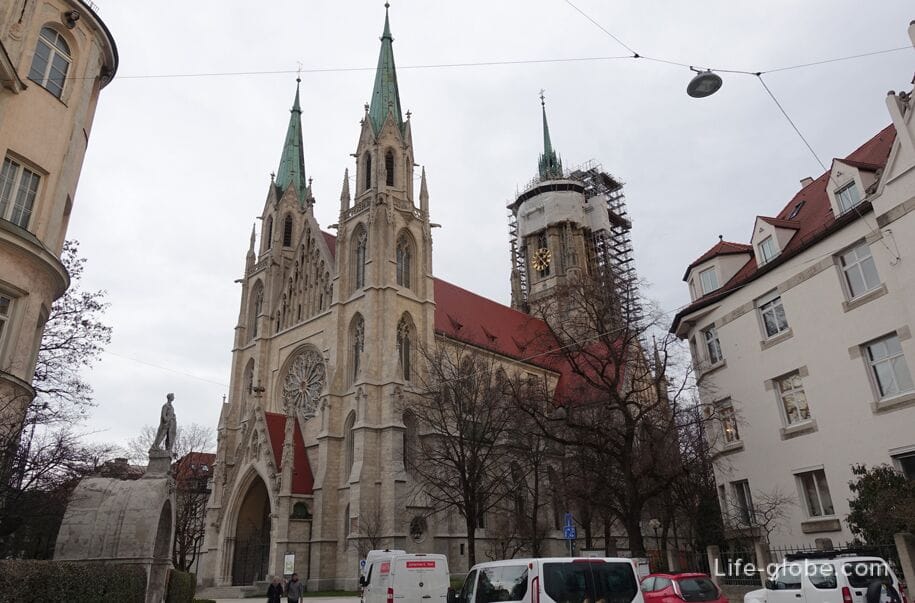
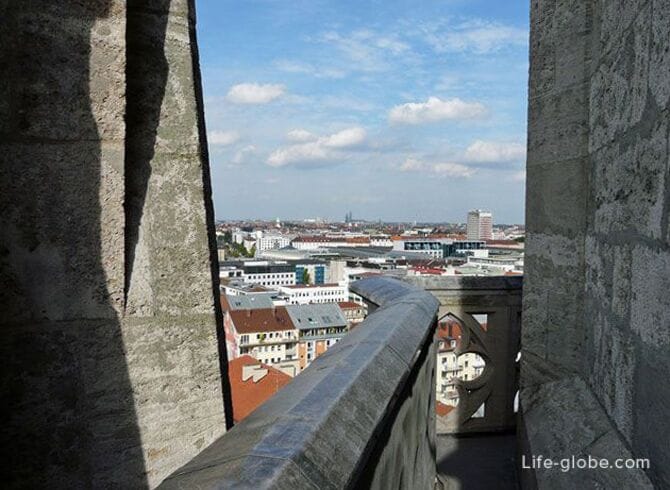
All accommodation options in Munich, including near the most attractive squares and in the city center, can be viewed and booked here




